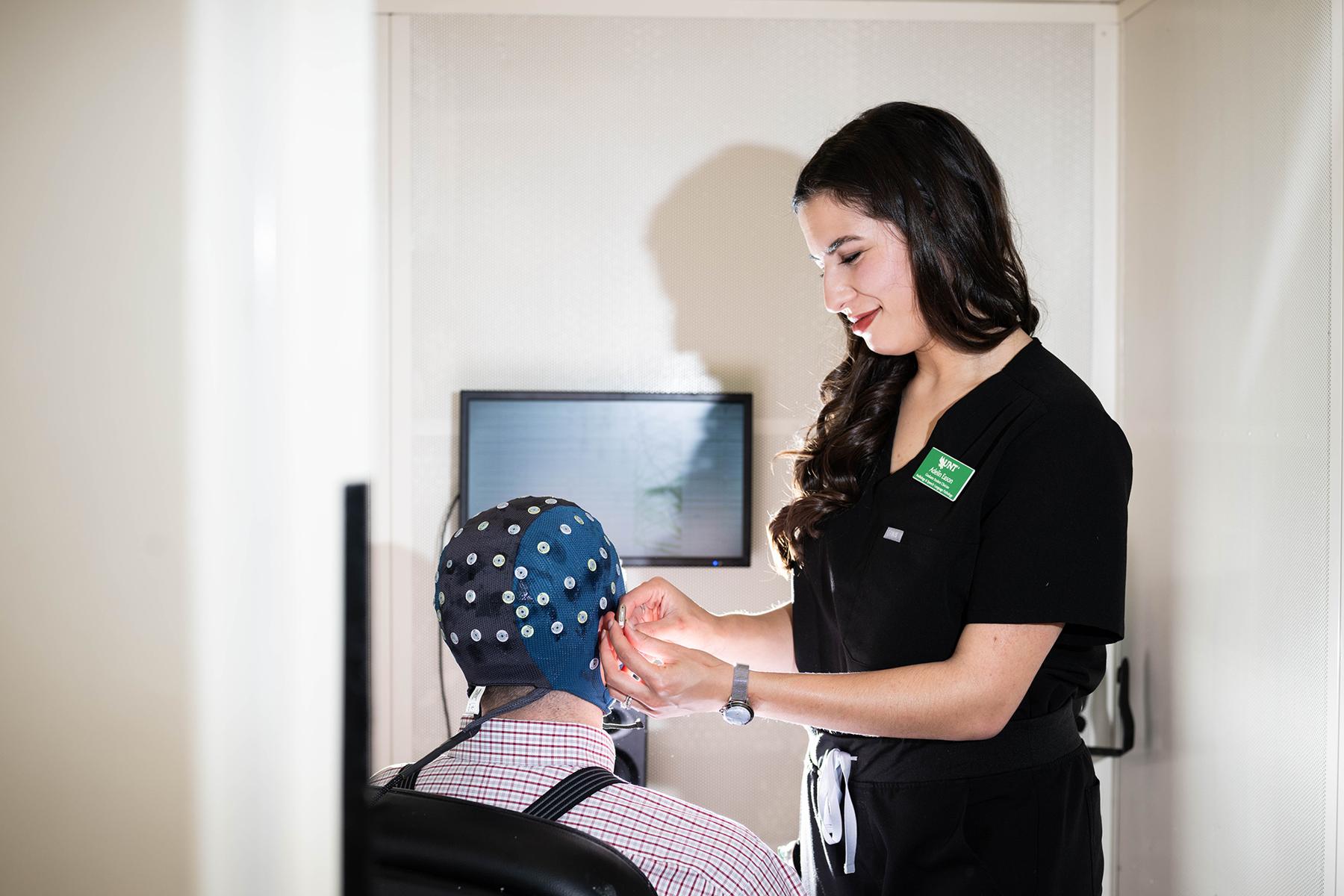Audiology researchers say hearing aids can improve cognitive performance, emotional
state in users
Audiology researchers in the UNT College of Health and Public Service are one step
closer to understanding what drives better hearing aid acceptance among new users.
Sharon Miller, Erin Schafer and Boji Lam — faculty in the Department of Audiology
and Speech-Language Pathology — shared preliminary findings in a study examining how
factors such as emotions, psychological wellbeing and cognition were affected by hearing
aid use. The study is funded through a grant from the Hearing Aid Industry Research
Consortium.
April 22, 2024

UNT audiology doctoral candidate Adelin Eason places a cap filled with electrodes
used in the hearing aid study. (Photo: Pete Comparoni /UNT)
Audiology researchers in the UNT College of Health and Public Service are one step closer to understanding what drives better hearing aid acceptance among new users.
Sharon Miller, Erin Schafer and Boji Lam — faculty in the Department of Audiology and Speech-Language Pathology — shared preliminary findings in a study examining how factors such as emotions, psychological wellbeing and cognition were affected by hearing aid use. The study is funded through a grant from the Hearing Aid Industry Research Consortium.
Beginning in June 2022, they recruited 30 participants between the ages of 50 to 85 who purchased hearing aids from the UNT Speech and Hearing Center on campus. Through a series of study sessions and hearing aid use monitoring, the UNT research team is gaining a better look at what cognitive and emotional performance changes occur during hearing aid adoption.
“If we can understand what factors are important for helping people adopt hearing aids, then we can design protocols and maybe even some auditory training to help patients get those better outcomes,” Miller says.
Faculty and student researchers conduct tests before participants start wearing their hearing aids, then again after two months and four months of use. The notable findings so far include:
- More ease with communication
- Increased fluid cognition
- Improved overall emotional health
Schafer says their data shows that those participants that wear their hearing aids more often had a higher general life satisfaction as well as lower levels of sadness, stress and fear.
“So, we’re seeing the importance of cognition and emotion around hearing aid use,” Schafer says. “They’re all related because they make the whole person.”
Miller is leading the objective side of testing in the study. Through high density EEG research, they can get insight into the changes hearing aid users have in their brain. For the test, the participant is fitted with a cap akin to what a swimmer might wear, except this one has dozens of electrodes that function as microphones to pick up brain signals.
Typically, only 30% of adults who would benefit from hearing aids actually get them, so we’re hopeful the results of our research will promote better adoption and success with hearing aids.
“When someone has hearing loss that’s left untreated, their brains can be hyperresponsive to sound. They have too much gain in the system to compensate for the lack of input in the ear,” Miller says. “What we found in our participants, is that after four months of hearing aid use, there was a significant reduction of this hyperresponsiveness, meaning that they were getting better at inhibiting irrelevant sound.”
Audiology students like doctoral candidate Adelin Eason have been crucial to leading the sessions with study participants. Not only has Eason learned research techniques, but she also is developing valuable clinical skills.
“Every research subject interaction I have is an opportunity for me to grow,” Eason says. “When people come into the clinic, research participation is just a piece of their life, so you end up talking about their families, their children and their work. Getting to practice how to build rapport with people through this research is going to make me a better audiologist in the future.”
Data collection with participants in the study will be ongoing through August. Next, Miller, Schafer and Lam hope to build on their research by studying other segments of people including those that need hearing aids but opt not to use them and people who purchased over-the-counter hearing aids following the FDA’s approval to expand access in October 2022.
“We have a very low adoption rate for hearing aids in the U.S.,” Miller says. “Typically, only 30% of adults who would benefit from hearing aids actually get them, so we’re hopeful the results of our research will promote better adoption and success with hearing aids.”